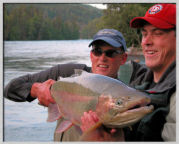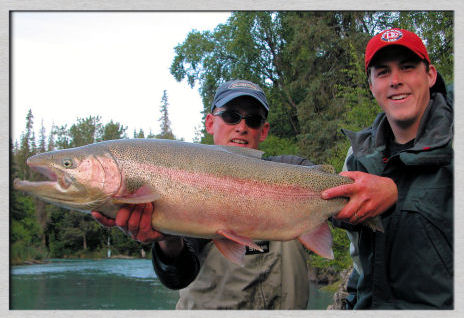|
Dustin's Big Trout

Dustin placed his cast perfectly on the seam and everyone in the boat watched his drift with vicarious anticipation. The result was beyond expectation. The river parted and 34” of panicked rainbow cleared the water once, twice, three times amid spray, colorful flashing and expletives from the anglers watching. I shouted directions and tried to portray calm as my heart raced and blood pressure surged. Would the line hold? Did the hook find a strong purchase? Would the fish bolt off on an unstoppable run?
Hooking jumbo sized rainbows is phase 1 and never happens as frequently as one would like. Landing these very large fish seldom follows the hook-up. So many things can go wrong in the first tenuous moments. The fish truly have many advantages. The current is often strong. Maintaining even pressure can be difficult as the fish jumps, twists and then peels line on the subsequent run. If the line initially holds, there are many obstructions such as rocks and woody debris to end the game. If the fish chooses to run upstream in heavy current, the boat-bound anglers are simply unable to follow. If the fish runs downstream, the chase is on, but the boatman had better choose the correct path between boulders, gravel bars, logjams and channels.
Dustin made it though phase 1 and the fish settled into a deep run. We parked the boat and tried to wait him out. Phase 2 requires wearing the fish down. Time seems immeasurable and the fish seem tireless. During phase 2, the angler and those watching cannot help but think of all the ways the fish could escape. The longer phase 2 is, the more nervous anglers get. In a perfect scenario, the angler stays close to the fish and maintains maximum lateral pressure, while at the same time trying not to panic the fish into further desperate evasions. It is important to stay calm and focused for phase 3.
Phase 3 requires leading the monster into the net. Too much pressure or lack of patience can quickly part a leader. It often happens and it hurts badly. The angler must keep the pressure on without increasing it beyond the tolerance of the fish to panic or the line to break. It can be an acquired skill, but often, big fish end up on novice angler’s lines. After 30 some minutes, the fish seemed to tire enough to lead gently toward my waiting net. It was not an ideal spot and my heart was hammering. If Dustin could ease the fish in, I could subtly lift the net under him. It was a long reach, but there was no other option. If the fish took off again, we would be forced into fast turbulent water with no hope of stopping for some distance.
As the fish neared, I could just feel that he was going to make a last surge. I told Dustin to be ready for a run and not to hold back if the fish panicked. The fish was clearly tired, but his size was now his advantage. He turned his nose toward heavier water and the current took him away from us. By the time I was back in the boat and we were underway, Dustin was into backing and I did not know for certain were the fish was. With so much line out in swirling current, a fish will often stop or change direction. The line will continue to point downstream and the boat can easily overtake the fish with disastrous results.
I tried desperately to slow the boat as Dustin retrieved line as rapidly as possible. The now exhausted trout came up right near the boat. He caught a small eddy current and ended up behind a jagged boulder, as I was swept helplessly downstream. It could not be. After all the time invested surviving phase 1 and 2, it looked like phase 3 would elude us. I struggled desperately to slow the boat and to ease it over in the next eddy; sure, that anything I could do would not be enough.
I managed to get the boat stopped and to ease out in waist deep water with the net. It was a struggle upstream toward the boulder where I could see Dustin’s indicator stuck in a crevice on top of the rock. Would the fish still be at the end of the leader? He was surly gone, but I had to find out. With the fly line over my shoulder, I reached out with the handle of the net toward the indicator. At the moment I lifted, the line surged and off it went, around the rock, back into the heavy downstream flow and straight toward Dustin. As I turned, I was rewarded with the sight of Dustin reeling frantically, while floundering in water over the top of his hip boots. Thankfully, Dustin and I both have long legs. We managed to get back into the boat and followed the fish again.
It was a short distance to the next possible landing zone. At the top of a small channel, we made our final stand. If the fish made a run down the channel, our efforts would be in vain. It was another calculated risk, but I felt that with his size, the fish would opt to stay in deeper water. The beast was tired and it was only a matter of a few long drawn minutes before Dustin completed phase 3. The beast finally swam over my submerged net and I managed to fold him in.

Phase 4 required holding twenty some pounds of rainbow for photos. Phase 4 was pure pleasure! Congratulations Dustin and thanks for letting me hold your fish.
Another Fish Tail
Site Map
Mystic Waters Home
Site Map
EMAIL
Call or Text 509-715-9697
Kenai River - Cooper Landing, Alaska

© Mystic Waters Inc., You must obtain written permission to use any content from this website.
|